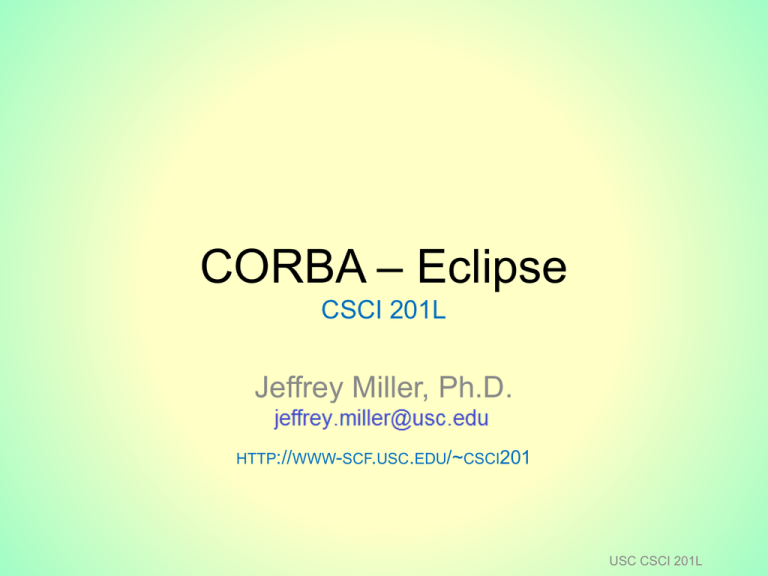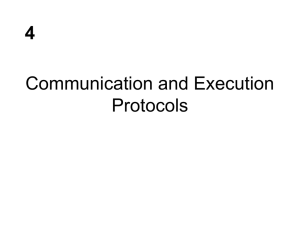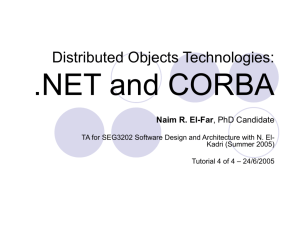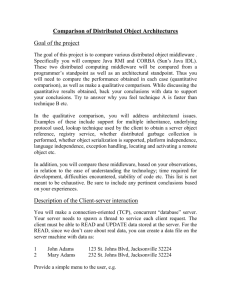CORBA-Eclipse
advertisement

CORBA – Eclipse
CSCI 201L
Jeffrey Miller, Ph.D.
HTTP://WWW-SCF.USC.EDU/~CSCI201
USC CSCI 201L
Outline
▪ CORBA
▪ Program
USC CSCI 201L
2/25
CORBA Overview
▪ The Common Object Request Broker Architecture
(CORBA) is the Object Management Group’s (OMG)
open, vendor-independent architecture and
infrastructure that computer applications use to work
together over networks
› http://www.omg.org/gettingstarted/corbafaq.htm
▪ CORBA is operating system- and languageindependent
▪ CORBA uses IDL to map programming language
specifics to OMG standards, with mappings from IDL
to C, C++, C++11, Java, Ruby, COBOL, Smalltalk,
Ada, Lisp, Python, and IDLscript defined
CORBA
USC CSCI 201L
3/25
CORBA Request
▪ CORBA clients communicate with an IDL stub,
which is automatically generated from an IDL file
▪ CORBA servers communicate with an IDL skeleton,
which is automatically generated from an IDL file
▪ The Object Request Broker (ORB) in the middle
performs the communication and passes the data
along in a standardized format from the stub to the
skeleton
CORBA
USC CSCI 201L
4/25
CORBA Application Example
▪ Here are the steps for setting up a CORBA
application
1. Write the code
1.1 Write the IDL file
1.2 Generate the stub and skeleton code
1.3 Write the server code
1.4 Write the client code
2. Compile the code
3. Start the ORB server, server application, and client
application
CORBA
USC CSCI 201L
5/25
CORBA Application Example – Step 1.1
▪ Step 1.1 – Write the IDL file
› Create a project in Eclipse
› The IDL file defines the interface that will be used by the
client and server for communicating and passing objects
› When the IDL file gets compiled, it will produce a number
of files, known as the stub and skeleton
• The stub is used by the client to communicate with the server
• The skeleton is used by the server to communicate with the client
• The stub and skeleton communicate with the ORB server to
facilitate the remote procedure call
› The module in the IDL file will correspond to the package
and directory in which the Java code will be generated
CORBA
USC CSCI 201L
6/25
CORBA Application Example – Step 1.1
▪ Step 1.1 – Write the IDL file
› To create the IDL file in Eclipse, right-click on the project and select New->File
› Name the file sum.idl then type the code below
1
2
3
4
5
CORBA
module SumApp {
interface SumServer {
long sum(in long a, in long b);
};
};
USC CSCI 201L
7/25
CORBA Application Example – Step 1.2
▪ Step 1.2 – Generate the stub and skeleton code
› There is an idlj program that comes with the JDK for
generating the stub and skeleton code in Java
› The following files will be generated by the idlj program for
the previous IDL file
•
•
•
•
•
•
CORBA
_SumServerStub.java
SumServer.java
SumServerHelper.java
SumServerHolder.java
SumServerOperations.java
SumServerPOA.java
USC CSCI 201L
8/25
CORBA Application Example – Step 1.2
▪ Step 1.2 – Generate the stub and skeleton code
› To run idlj within Eclipse, go to “Run->External Tools->
External Tools Configuration…”
CORBA
USC CSCI 201L
9/25
CORBA Application Example – Step 1.2
▪ Step 1.2 – Generate the stub and skeleton code
› Click the “New Launch Configuration” button and name it “idlj”
› For the “Location,” click “Browse File System” to find the idlj program in the
bin directory of your JDK directory
› For the “Working Directory,” click “Browse Workspace” to find your project
directory
› Type the following in the “Arguments” box
-td src –fall sum.idl
› Click “Apply” then “Run” – the stubs and skeletons should be generated
CORBA
USC CSCI 201L
10/25
CORBA Application Example – Step 1.2
▪ Step 1.2 – Generate the stub and skeleton code
› The stubs and skeletons should have been generated in the src directory, so
right-click on the project and click “Refresh” to see them
› You should see the SumApp package in your project now
CORBA
USC CSCI 201L
11/25
CORBA Application Example – Step 1.3
▪ Step 1.3 – Write the server code
› The server program will inherit from the SumServerPOA
class that was generated as part of the idlj program
› The SumServerPOA class implements the
SumServerOperations interface
• This interface contains the methods we defined in the sum.idl file,
but standardized to Java
› We create a main method in here also to communicate
with the object request broker (ORB), registering the
server with the ORB so clients are able to find it
CORBA
USC CSCI 201L
12/25
CORBA Application Example – Step 1.3
1
2
3
4
5
6
7
8
9
10
11
12
13
14
15
16
17
18
19
20
21
22
23
24
25
26
27
28
29
30
31
package server;
import org.omg.CosNaming.*;
import org.omg.CORBA.*;
import org.omg.PortableServer.*;
import SumApp.*;
public class SumServerImpl extends SumServerPOA {
public int sum(int a, int b) {
System.out.println("adding " + a + " and " + b + " together");
return a+b;
}
public static void main (String [] args) {
try {
ORB orb = ORB.init(args, null);
POA rootpoa = POAHelper.narrow(orb.resolve_initial_references("RootPOA"));
rootpoa.the_POAManager().activate();
SumServerImpl ssi = new SumServerImpl();
org.omg.CORBA.Object ref = rootpoa.servant_to_reference(ssi);
SumServer ss = SumServerHelper.narrow(ref);
org.omg.CORBA.Object objRef = orb.resolve_initial_references("NameService");
NamingContextExt ncRef = NamingContextExtHelper.narrow(objRef);
NameComponent path[] = ncRef.to_name("SUM-SERVER");
ncRef.rebind(path, ss);
System.out.println ("Sum Server is running . . . ");
orb.run();
} catch (Exception e) {
System.out.println ("Exception: " + e.getMessage());
}
}
}
CORBA
USC CSCI 201L
13/25
CORBA Application Example – Step 1.3
▪ Step 1.3 – Write the server code
CORBA
USC CSCI 201L
14/25
CORBA Application Example – Step 1.4
▪ Step 1.4 – Write the client code
› The client program needs to get a reference to the ORB
then resolve the name of the server object it would like to
invoke
• This is SUM-SERVER in this case
› After getting an instance of a SumServer object from the
server, it can invoke methods on it just like a method
within its own JVM
CORBA
USC CSCI 201L
15/25
CORBA Application Example – Step 1.4
1
2
3
4
5
6
7
8
9
10
11
12
13
14
15
16
17
18
19
package client;
import org.omg.CosNaming.*;
import org.omg.CORBA.*;
import SumApp.*;
public class SumClient {
public static void main (String [] args) {
try {
ORB orb = ORB.init(args, null);
org.omg.CORBA.Object objRef = orb.resolve_initial_references("NameService");
NamingContextExt ncRef = NamingContextExtHelper.narrow(objRef);
SumServer ss = SumServerHelper.narrow(ncRef.resolve_str("SUM-SERVER"));
int addSolution = ss.sum(20, 30);
System.out.println ("20 + 30 = " + addSolution);
} catch (Exception e) {
System.out.println ("Exception: " + e.getMessage());
}
}
}
CORBA
USC CSCI 201L
16/25
CORBA Application Example – Step 1.4
▪ Step 1.4 – Write the client code
CORBA
USC CSCI 201L
17/25
CORBA Application Example – Step 2
▪ Step 2 – Compile the code
› Eclipse compiles dynamically, so there is nothing else we
need to do here
CORBA
USC CSCI 201L
18/25
CORBA Application Example – Step 3
▪ Step 3.1 - Start the ORB server
› orbd is another program that comes with the JDK, so we
need to configure it as an External Tool in Eclipse with the
following arguments
-ORBInitialPort 1050 -ORBInitialHost localhost
CORBA
USC CSCI 201L
19/25
CORBA Application Example – Step 3
▪ Step 3.2 - Start the server application
› Start the server application with the following command
line arguments
-ORBInitialPort 1050 -ORBInitialHost localhost
CORBA
USC CSCI 201L
20/25
CORBA Application Example – Step 3
▪ Step 3.2 - Start the server application
› If it starts successfully, you should see the following output
CORBA
USC CSCI 201L
21/25
CORBA Application Example – Step 3
▪ Step 3.3 - Start the client application
› Start the client application with the following command line
arguments
-ORBInitialPort 1050 -ORBInitialHost localhost
CORBA
USC CSCI 201L
22/25
CORBA Application Example – Step 3
▪ Step 3.3 - Start the client application
› If it runs successfully, you should see the following output
CORBA
USC CSCI 201L
23/25
Outline
▪ Interface Definition Language
▪ CORBA
▪ Program
USC CSCI 201L
24/25
Program
▪ Create a CORBA program where the CORBA server
object communicates over RMI to find the value of Pi
to a certain number of digits
▪ Utilize the RMI code from the previous lecture
Program
USC CSCI 201L
25/25





